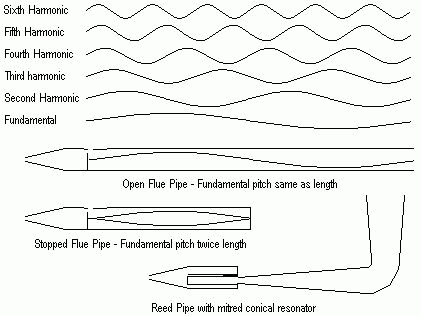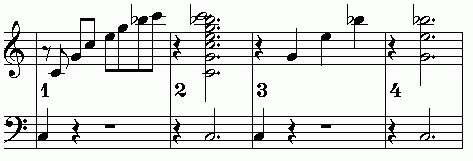
Using Layering Techniques to Simulate
Pipe Organ Sounds with General MIDI

Using Layering Techniques to Simulate
Pipe Organ Sounds with General MIDI
Many organ works available on the Web are rarely voiced or arranged in a way that effectively simulates the sound of the pipe organ.
Often, pieces are totally unvoiced, so that whatever patch happens to be in the sound card is what is heard, or else the ubiquitous "church organ" (patch 20) is used. "Church organ" is a useful sound, approximating a "full organ", but the very richness of the patch tends to make it monotonous and tiring to the ear in a short time.
I have found that layering other sounds, such as flutes, woodwinds, and other instruments, can provide an effective simulation of the tonal spectrum available in a real pipe organ. Layering involves using duplicate tracks to play the same parts, sometimes transposed, on two or more different MIDI channels using different sounds.
The following examples will illustrate. First, an excerpt from the well-known "Bouree" by J. S. Bach, using the "church organ" patch:
Play this example. Second, the whole "Bouree" with the right hand using "Pan Flute" with "Ocarina" an octave and a fifth higher, and the left hand using "Calliope" with "Pan Flute" an octave lower:
Play this example.
You can see how this not only improves the ears' ability to separate the voices, but gives the piece the kind of intimacy one would want for a piece of this simplicity.
As many of my readers may not be familiar with the workings of pipe organs, allow me a digression.
All vibrating bodies, be it strings, bars, or columns of air, vibrate at a natural frequency that is dependent on the length of the vibrating medium. This is known as the fundamental or natural frequency.
These bodies will also produce "harmonics" or "overtones" of whole number multiples of the fundamental frequency, such as:
the octave (twice the fundamental);
the twelfth (an octave and a fifth)(3x), (also known as a "quint");
the fifteenth (two octaves)(4x);
the seventeenth (two octaves and a third)(5x),(also known as a "tierce");
and so on.
A typical "open" organ pipe, or any other column of air, such as a trumpet or flute, for instance, that is approximately two feet long will produce a fundamental roughly corresponding to middle C. Doubling the length will halve the frequency, lowering the pitch an octave, halving the length will double the frequency, raising the pitch an octave.
A "stopped" pipe, which has a plug or stopper in the end, has the sound wave reflected from the closed end, so that the effective length is twice the actual length. Therefore, a stopped pipe of 8' pitch is only 4' long. In addition to providing a unique sound, stopped pipes are often used in the pedal registers of smaller organs to save space and cost. Stopped pipes are peculiar in that as a result of the reflection all the even harmonics (2x, 4x, 6x, 8x, etc.) are damped out, which results in a typical "hollow" tone. For acoustically similar reasons, a clarinet has little even harmonics, therefor a clarinet patch is very effective as a simulation of a stopped pipe sound.
Pipes are also divided into two groups or families based on the method of sound production. "Flue" pipes are essentially similar to recorders or whistle flutes, in that the air is directed against an edge, where it drives an oscillation at the resonant frequency of the pipe. "Reed" pipes use a metal tongue driven by the air to produce the oscillation, and the resultant pitch and sound is influenced by both the tongue and the length of the pipe.

The following example will demonstrate the harmonic series. You will hear the whole series from 1 to 8 followed by these pitches sounding together, followed by just the odd harmonics (1-7) individually and then together.

Play this example.To learn more about harmonics, just ask any horn or string player.
Pipes in an organ are organized into groups of similar sounds, or "voicings". These groups are called "ranks". Organs can have as few as 1-4 ranks, as in chamber or residence organs, to as many as hundreds of ranks, with thousands of pipes, as in a large theater or church organ. Organists, in order to define the range of pitches available in the various ranks, use labels based on the length of the longest pipe in a rank.
Typically, a pipe organ keyboard, or "manual" will extend two octaves down from middle C, and three octaves up, so that the lowest pipe in a rank tuned to "unison pitch", or middle C, will be eight feet long. A rank that sounds middle C when middle C is depressed on the manual is called a rank of eight foot pitch, or simply an eight foot rank. A rank that sounds an octave higher is a 4' rank, two octaves higher 2', three octaves higher 1', an octave lower 16', two octaves lower 32' and so on.
Pipe organs date back to Classical Greek and Roman times but in those days all the pipes associated with a particular pitch sounded together. During the late Renaissance, a mechanism to "stop off" unwanted pipes in a particular part was invented, and for that reason a rank or group of ranks sounding together is called a "stop", (what we would call a "patch" in synthesizer terms). Stops, then, may consist of individual ranks, or combinations of ranks.
The important thing to remember is that all stops other than 8' are transposing, that is, the pitch produced is higher or lower than the note depressed on the keyboard.
Stops which reinforce the fundamental and octaves are called "Foundations" and are: unisons (8'), superoctaves (4', 2', 1') and suboctaves (16', 32', and sometimes even 64'). (Yes, the lowest pipes are really 64 feet long, although they are often folded or "mitered" to save space. The high notes of a 1' stop are very short, 1/4 inch or so.)
Stops which reinforce the odd harmonics are called "Mutations" and are: Quints (fifth [5-1/3'], twelfth [2-2/3'], and nineteenth [1-1/3'], reinforcing the fifth of the scale); and Tierces (tenth [3-1/5'], and seventeenth [1-3/5'], reinforcing the third of the scale).
With MIDI, octaves are produced by transposing up or down 12 or 24 semitones. Quints are produced by transposing the part upward 7, 19, or 31 semitones. Tierces are produced by transposing the part up 16 or 28 semitones.
Stops which are primarily groups of unisons and octaves are called "choruses". Stops which are groups of upper harmonic reinforcements and which are commonly used in combination with foundations are called "mixtures". Stops which combine groups of foundations, mutations and/or mixtures are called, not surprisingly, "combinations".
The following example will illustrate.

Play this example.Remember, these notes or groups of notes would all result from playing middle C on the keyboard.
Foundations:
Measure 1 - 8 foot(')
Measure 2 - 4'
Measure 3 - 2'
Measure 4 - 8', (middle C) again for reference
Measure 5 - 16'
Measure 6 - 32'Chorus:
Measure 8 - short phrase on middle C - 8'+4'+2'
Measure 9-1/2 - pedal added 16'+32'
Measure 11 - 8', (middle C) again for referenceMutations:
Measure 12 - 2-2/3'
Measure 13 - 1-3/5'
Measure 14 - 1-1/3'Typical mixture:
Measure 15 - short phrase - 8'+4'+2-2/3'+2'+1-1/3'
Measure 16-1/2 - pedal added - 32'+16'+5-1/3'
Our next example demonstrates layering to simulate combinations. A brief excerpt from Partita No.3 by J. S. Bach, repeated with a cadence added:
Play this example. Excerpt - violin
Organ parts (lowered an octave for clarity)
1st. repetition - 8' (recorder)
2nd. repetition - add 4' (piccolo)
3rd. repetition - add 2' (ocarina)
4th. repetition - add 16' (flute)
5th. repetition - add 2-2/3' (pan flute)
Cadence - right hand (great) 8'+4'+2-2/3'+2' - left hand (swell) 8'+4'+2' - pedal 16'+32'
I will now demonstrate the production of an organ piece from a typical non-organ work. The song is called "Feather Song" by Rick Ho. Here is the original sequence:
Play this example. Next we derive the organ score. I used the piano Right Hand as the melody (great manual), the piano Left Hand plus the first string part as the accompaniment (swell manual), and the horn part as the pedal. All other parts were discarded. All note velocities were averaged to provide a uniform level. All voices use patch 20 (church organ).
Play this example. Now, using the score from the previous example, we proceed to derive the finished work. The melody (great) is layered with the following voices: trombone 8', church organ 8', piccolo 4', English horn 8', and piccolo 2-2/3'. The accompaniment (swell) is layered with English horn 8', piccolo 1-1/3', ocarina 2-2/3', and mute trumpet 8'. The pedal is layered with church organ 2-2/3', trombone 8', flute 8', and flute 16'.
Play this example.
My final example is Charles Ives' "Variations on 'America' (1891)." All voices are two-layer only, but there are many patch changes "on the fly." This is in fact the most complex organ voicing I have attempted so far. I have heard this piece performed three times live, and I have several recordings of it, and I think this voicing does it justice.
Play this example.
Patches used in this file are: FLUES:
flute
piccolo
recorder
flute
shakuhachi
calliopeREEDS:
accordion
reed organ
bassoon
violin
soprano sax
clarinet (stopped pipes)
This by no means exhausts the possibilities of voicing with General MIDI. I have also used trumpet, tuba, tenor and alto sax, tremolo strings (used as a 1' or 2' stop), oboe, shanai, bagpipe, organ 1, 2, and 3, harmonica, fretless bass, bottle blow, and fiddle as pipe stops.
Generally I try the various patches until I find one that suits the part, then add one or two others that reinforce the particular sound I am after, transposing as necessary.
It is critical to be aware of the total number of voices available with your particular sound card, so as not to have sounds cut off unexpectedly. Practically, this means that you may only have layers of four or five patches when the parts are solo voices. A chord of four parts, for example, with a four layer patch setup, will require sixteen voices, which may not leave many for pedals or melody.
One final note: If your sound card has adjustable reverb, lots of reverb, set to a large hall setting, will add to the realism. Similarly, chorusing should be set fairly high. Pan settings on each part should be adjusted to provide a wide aural spread.
Those of you who have made it this far are obviously interested in pipe organs. You may find the following links of interest:
The Boston University Symphonic Organ
The Austin Organ CompanyPipe Dreams - How an Organ Works
Home If you have suggestions or comments
send email to pinwiz.geo @ geocities.com. (remove spaces).Thanks for visiting The PinWiz.
Last update May 23, 2011
Please come back again soon.© 1998, 1999, 2000, 2011 Bill the PinWiz
This page hosted by

Get your own Free Home Page